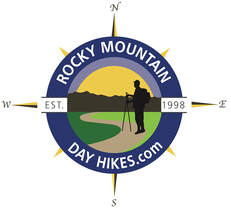|
Notes from the
Trail |
|
Trailhead: Finch Lake Trailhead Elevation: 8,476' Destination Elevation: Finch Lk-9,925', Pear Lk-10,594', Cony Lk-11,512' Total Roundtrip Miles: Finch Lk-10, Pear Lk-12.4, Cony Lk-18.4 In the south end of Rocky Mountain National Park, as part of the Wild Basin trail system, there are a series of lakes that begin at the Finch Lake trailhead and can give the dayhiker some options on a trail that is not too crowded, but the destinations are all longer hikes.
The trail actually loses some elevation on the last strech to Finch Lake. There are a couple of good rock spots along the eastern shoreline to enjoy this peaceful lake. Finch Lake is a comfortable distance for many dayhikers, and well worth the effort. But for another 2.5 miles, you can also bag Pear Lake. The trail skirts around the north side of Finch Lake, then drops a bit more to a footbridge crossing Cony Creek. There's not too much elevation gain between the two lakes and the trail is pleasant.
This trial is not an official trail of the Park. It is not maintained and there will be some downfall to climb over, for example. If the dayhiker is going to travel here, you will want to plan on a much longer day. After passing the lower of the three Hutcheson Lakes, the trail can be difficult to keep track of, so it's necessary to have an awareness of your surroundings. Having a topographical map and knowing how to read it is also a good idea. This is a pristine alpine environment, so travel carefully. Follow the small trail to reach the Middle Hutcheson Lake. The three Hutcheson Lakes each sit on a self with the lower lake still below treeline, the middle lake in the subalpine and the upper lake right at treeline. Carefully navigate over rock outcrops that look over Middle Hutcheson Lake to reach into the upper basin and Upper Hutcheson Lake. The upper Cony Basin begins to come into full view as the dayhiker approaches Upper Hutcheson Lake. Cony Pass that leads over to the Bluebird Lake basin to the north, can be seen in the distance. Ogalalla Peak can also be seen now. On our day, we decided to travel up to the base of Coney Pass. The pass is steep with lots of loose scree. We reach our high point standing below Ogalalla Peak. The summit, 13,138', is part of the Continental Divide and is a high point marking the south boarder line of the National Park. We then turn our attention east looking at where we have come, and now our return route. We can see Cony Lake below us. Nearby is the prominent Elk Tooth with Meadow Mountain in the far distance. Both of these peaks define the southeast boundary of Rocky Mountain National Park.
0 Comments
Leave a Reply. |
"The wild requires that we learn the terrain, nod to all the plants and animals and birds, ford the streams and cross the ridges, and tell a good story when we get back home." ~ Gary Snyder
Categories
All
“Hiking -I don’t like either the word or the thing. People ought to saunter in the mountains - not hike! Do you know the origin of the word ‘saunter?’ It’s a beautiful word. Away back in the Middle Ages people used to go on pilgrimages to the Holy Land, and when people in the villages through which they passed asked where they were going, they would reply, A la sainte terre,’ ‘To the Holy Land.’ And so they became known as sainte-terre-ers or saunterers. Now these mountains are our Holy Land, and we ought to saunter through them reverently, not ‘hike’ through them.” ~ John Muir |
© Copyright 2025 Barefoot Publications, All Rights Reserved





























